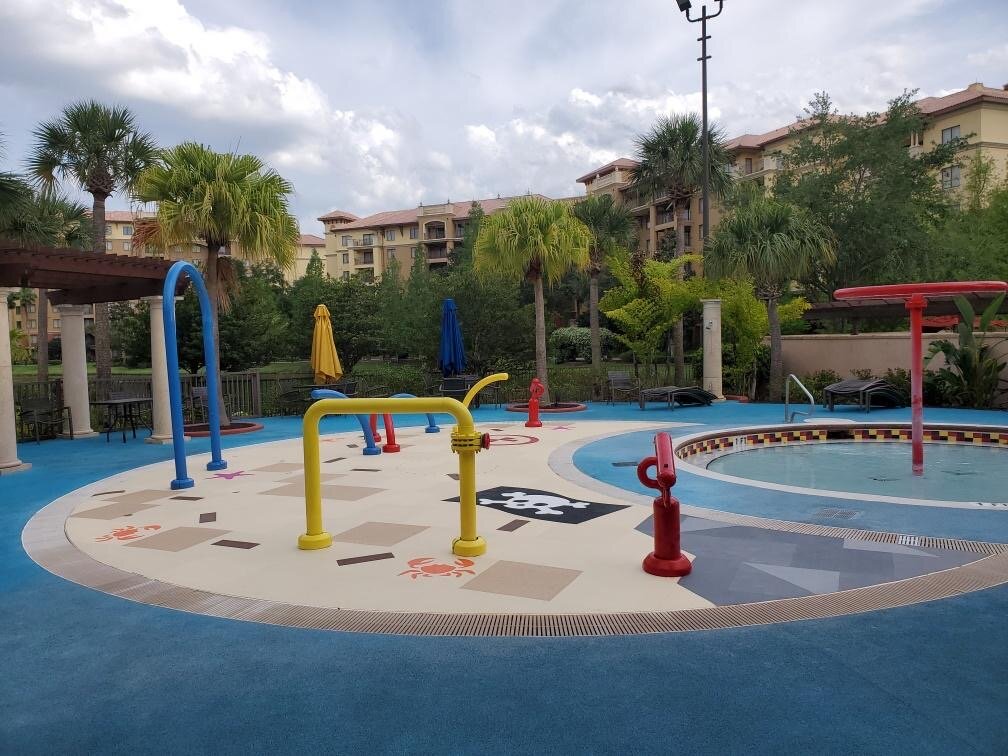Recently, NSF International expanded Standard 50 to extend across Canada, which includes recommendations for surfacing in aquatic play areas under NSF/ANSI/CAN 50:26 (formerly NSF/ANSI 50:26).
With its recent Life Floor installation, the YMCA of Greater Moncton, NB is one of the first aquatic facilities in Canada to recognize the importance of having NSF/ANSI/CAN 50:26 certified safety surfacing. The facility is a combination of an indoor splash pad with a zero-depth entry and a playground. Because of this unique configuration, the staff sought out a product that was able to transition seamlessly from wet to dry applications while maintaining their commitment to safety. To accomplish this, they selected Life Floor to be installed.
“Having seen Life Floor at a major trade show, we knew it was the product we wanted to install in our new facility.”
A custom beach-inspired design was chosen to complement the existing tropical theming. Life Floor’s foam-rubber tiles were able to create the perfect transition the YMCA needed between the wet and dry play areas, especially since splash pads are essentially wet playgrounds. The cushioned and impact-absorbing surfacing allows children to run, jump, and play without limits - never needing to stop and put on shoes or change the way they play from one area to the next. As a result, the fully immersive experience enhances imaginative play.
The YMCA of Greater Moncton is skipping ahead of their competition by creating a facility full of imagination, play, and fun. They have created a holistic experience to provide their members with the perfect beach day right in their community’s backyard.
We thank the YMCA of Greater Moncton for their commitment to safety and for being one of the first in Canada to adopt NSF/ANSI/CAN 50:26 safety surfacing standards for the benefit of their members. We look forward to the future as more Canadian facilities follow their example and recognize the importance of this safety standard as an integral part of their business.
To learn more about the official code in your region or state, check out this free resource.
If you’d like to specify or install NSF/ANSI/CAN 50:26 surfacing for an aquatic play area in Canada, please contact our Canadian Partner, Paul-Émile Beaudry at pebeaudry@polyvalens.ca to assist you in both English and French.
For U.S. clients and all other inquiries, please contact us directly via our online contact form or send us an email at solutions@lifefloor.com.
French Translation
Le YMCA du Grand Moncton, NB crée un précédent sécuritaire en milieu aquatique au Canada.
Récemment, NSF International a étendu la norme Standard 50 partout au Canada, incluant des recommandations pour les surfaces de jeu aquatiques sous l’appellation NSF/ANSI/CAN 50,26 (précédemment nommée NSF/ANSI 50:26).
Avec ses récentes installations de Life Floor, le YMCA du Grand Moncton, NB est l’un des premiers centres d’installation aquatique à reconnaître l’importance d’avoir une surface sécuritaire certifiée NSF/ANSI/CAN 50:26. En effet, l’établissement se compose d’un mix de deux (2) aires de jeux, l’une étant une surface mouillée (indoor splash pad) plane et l’autre étant une aire de jeux sèche. À cause de cette configuration spéciale, les employés ont recherché un produit qui permettrait la transition en toute transparence, de la surface mouillée à la surface sèche pour leurs activités tout en gardant un engagement de sécurité irréprochable. Un seul choix leur permettait de tout rallier : Life Floor.
Après avoir vu Life Floor lors d'un grand salon, nous avons sû que c’était le produit que nous voulions pour nos installations ! —Scott Munro, Vice Président du YMCA du Grand Moncton, NB
Au niveau du design, le thème tropical dans l’aire de jeu d’eau et le thème plage dans l’aire de jeu sèche sont en parfaite harmonie pour s’adapter au thème pré-existant. Et maintenant, les enfants peuvent donc courir, sauter, culbuter et jouer sans limites sur une surface conforme aux nouveaux standards. Les surfaces coussinées et absorbant tout impact permettent aux enfants de jouer sans s’arrêter pour mettre leurs chaussures ou changer leur façon de jouer d’un endroit à l’autre. Comme résultat, l’expérience devient totalement immersive et renforce leur jeu imaginatif.
Le YMCA du Grand Moncton devient donc un chef de file en adoptant des installations pleines d’imagination, de jeu et de plaisir ! Ils ont créé une expérience holistique en offrant à leurs membres une journée de plage parfaite en plein dans leur cour !
Nous remercions le YMCA du Grand Moncton de leur engagement pour la sécurité de leurs membres et d’être les premiers au Canada à appliquer la norme NSF/ANSI/CAN 50.26. Nous espérons que plusieurs autres organismes, centres aquatiques et municipalités suivront l’exemple du YMCA et reconnaîtront l’importance de l’application de cette recommandation comme faisant partie de leur politique d’opération .
Si vous désirez de plus amples informations sur les tuiles Life Floor, communiquez avec Polyvalens Inc, notre distributeur au Canada.

























